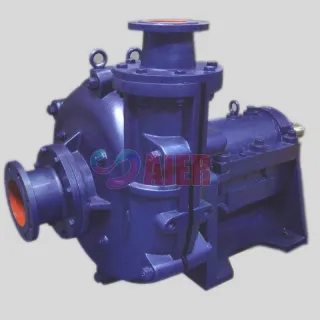Nov . 29, 2024 13:34 Back to list
Top Lime Slurry Pump Manufacturers in China for Superior Performance
The Best Pumps for Lime Slurry A Guide for Manufacturers in China
Lime slurry, a mixture of water and quicklime or hydrated lime, is widely used across various industries, including construction, chemical processing, and environmental management. The efficient handling of lime slurry is critical to ensure optimal performance in these applications. One of the key components in this process is the pump used to transport the lime slurry. This article explores the best pumps for lime slurry, particularly for manufacturers in China, focusing on efficiency, durability, and performance.
Understanding Lime Slurry
Lime slurry is a versatile product that serves multiple purposes, such as water treatment, soil stabilization, and as a raw material in the production of various chemicals. Because lime slurry has a high viscosity and contains solid particles, it poses unique challenges for pumping systems. Manufacturers need to select pumps that can handle these specific requirements without compromising efficiency.
Types of Pumps Suitable for Lime Slurry
1. Slurry Pumps Slurry pumps are designed specifically to handle mixtures that contain solid particles. These pumps feature robust materials and unique impeller designs that minimize wear and tear while ensuring a continuous flow of the lime slurry. High chrome alloys or rubber linings are often used to enhance the durability of these pumps, making them ideal for lime slurry applications.
2. Progressing Cavity Pumps Progressing cavity pumps are another excellent choice for transporting lime slurry. These pumps operate by using a series of rotating and stationary helical screws, effectively moving the slurry along without damaging the solid particles. They offer consistent flow rates and can handle varying viscosities, making them suitable for different lime slurry concentrations.
3. Gear Pumps Gear pumps are also utilized in some lime slurry applications. While they are not as common as slurry or progressing cavity pumps, their ability to deliver a steady flow makes them a viable option. However, manufacturers should ensure that the gear pump can effectively handle the abrasive nature of lime slurry.
Key Considerations When Choosing Pumps
china best pump for lime slurry manufacturers

1. Material Compatibility Given that lime slurry can be abrasive and corrosive, selecting a pump made from compatible materials is crucial. High-grade stainless steel, cast iron, or specially coated materials are often recommended to ensure longevity.
2. Capacity and Flow Rate Manufacturers need to assess the required flow rate based on their operational needs. Pumps should be chosen based on their capacity to handle the specific volume of lime slurry efficiently.
3. Maintenance and Serviceability The ease of maintenance is another factor to consider when selecting pumps. Opting for pumps that are easy to disassemble and repair can significantly reduce downtime and maintenance costs.
4. Energy Efficiency Energy-efficient pumps can help reduce operational costs over time. Manufacturers should look for pumps that offer a balance between performance and energy consumption.
Top Manufacturers in China
China is home to numerous manufacturers that specialize in slurry pumps suitable for lime applications. Companies like Schurco Slurry, Weir Minerals, and Sumitomo Heavy Industries offer a range of pumps that meet the rigorous demands of lime slurry transport. Additionally, local manufacturers are increasingly improving their technologies to match international standards, providing cost-effective solutions for domestic and global markets.
Conclusion
Choosing the best pump for lime slurry is vital for maximizing efficiency and ensuring the smooth operation of various industries. By understanding the properties of lime slurry and evaluating the different pump types available, manufacturers in China can make informed decisions that enhance productivity, reduce costs, and ensure high operational standards. Whether opting for slurry pumps, progressing cavity pumps, or gear pumps, the right choice will contribute significantly to the success of lime slurry applications.
-
Top Submersible Pump Companies High Quality Manufacturers & Suppliers in China
NewsJul.08,2025
-
High Quality Seal for 5 Inch Dredge Pump Reliable China Manufacturer & Supplier
NewsJul.08,2025
-
High-Efficiency Slurry Sand Pump from Leading China Manufacturer – Durable & Reliable Solutions
NewsJul.07,2025
-
High-Quality Slurry Pump Made in China Durable Steel Mill Slurry Pump & Parts
NewsJul.07,2025
-
High Quality Excavator Dredge Pump Manufacturer & Suppliers from China – Reliable, Durable, Efficient Solutions
NewsJul.07,2025
-
Wholesale Slurry Pump Closed Impeller Supplier High Efficiency China Slurry Pump Closed Impeller
NewsJul.06,2025
